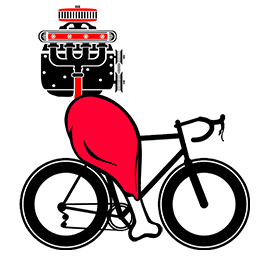The purpose of this study was to compare two different resistance training methods—traditional resistance training (TRT) and optimum power load training (OPT)—to determine which method produces better results when added to the usual cycling training schedule of professional cyclists. OPT provides an individualized training load and number of repetitions for each athlete to maximize their power output, while TRT uses the same load and repetitions for all athletes.
More on OPT
Optimum power load training (OPT) is a resistance training method that uses an individualized training load and number of repetitions for each athlete to maximize their power output. In OPT, the weights and reps are tailored to each athlete to optimize their power production. If an athlete can generate more overall power doing higher of reps with lower weights, this is the protocol adopted. Or the inverse can be true: higher weight with slightly less weights. This is in contrast to traditional resistance training (TRT), which uses the same load and repetitions for all athletes.
Some key points about OPT include:
•The training load and repetitions are customized for each athlete based on their strength and power abilities. Lighter weights and higher reps may be used for some athletes, while heavier weights and lower reps may be better for others.
•The goal of OPT is to maximize an athlete’s power output during resistance training. This is done by determining the optimum combination of weight and reps that allows them to generate the most power.
•OPT may use lighter weights and higher reps than traditional methods like TRT. But both can produce similar improvements in strength, power, and endurance.
•The individualized nature of OPT may make it more complex to implement compared to a standard approach like TRT. It requires assessing each athlete to determine the optimal training load and reps for power production.
The study found that OPT resulted in athletes using a lower percentage of their one-repetition maximum during training, meaning the weights were lighter. However, there were no differences between the two training methods in terms of the overall training load during either resistance training or cycling sessions.
Both TRT and OPT led to:
•Improved muscle strength and power based on squat, hip thrust, and lunge exercises.
•Gains in muscle mass with a decrease in fat mass and no change in total body weight.
•Better performance on an 8-minute time trial.
•A trend toward increased power output during high-intensity cycling, though this was not statistically significant.
There were no significant differences between TRT and OPT for any of the measured outcomes.
In summary, either traditional resistance training or optimum power load training produces similar benefits when added to the usual endurance training of elite cyclists. The specific implications and potential impacts for a competitive cyclist include:
•Either TRT or OPT can be an effective form of resistance training to boost muscle strength, power, and endurance. The cyclist can choose between the two methods based on personal preference and access to training equipment. Speculative implication: OPT may be preferable if lighter weights are more suitable for the cyclist’s needs or abilities.
•Gains in muscle mass and decreased fat mass may improve the cyclist’s power-to-weight ratio without an overall weight change, benefiting climbing ability and acceleration.
•Improvements in time trial performance and high-intensity power output can directly benefit the cyclist during races and competitions.
•The similar improvements from TRT and OPT suggest that lighter weights and higher reps of OPT may be a viable alternative if heavier weights for lower reps of TRT are not available or preferable. The cyclist can achieve comparable benefits from either approach. Speculative implication: OPT could be used when TRT equipment like barbells and weight plates are unavailable.
The implications listed here are supported by the results of the study, with the acknowledgment that they have not been tested in real-world conditions with competitive cyclists. The competitive cyclist can consider these implications as possibilities, but further research may be needed to determine how the different training methods directly impact cycling performance. The speculative implications are possibilities based on the results but have not been conclusively proven.
ABSTRACT FROM STUDY
Traditional Versus Optimum Power Load Training in Professional Cyclists: A Randomized Controlled Trial.
Published in International journal of sports physiology and performance
Citations: 5
2021
Abstract
PURPOSE To compare the effectiveness of optimum power load training (OPT, training with an individualized load and repetitions that maximize power output) and traditional resistance training (TRT, same number of repetitions and relative load for all individuals) in professional cyclists. METHODS Participants (19 [1] y, peak oxygen uptake 75.5 [6] mL/kg/min) were randomly assigned to 8 weeks (2 sessions per week) of TRT (n = 11) or OPT (n = 9), during which they maintained their usual cycle training schedule. Training loads were continuously registered, and measures of muscle strength/power (1-repetition maximum and maximum mean propulsive power on the squat, hip thrust, and lunge exercises), body composition (assessed by dual-energy X-ray absorptiometry), and endurance performance (assessed on both an incremental test and an 8-min time trial) were collected before and at the end of the intervention. RESULTS OPT resulted in a lower average intensity (percentage of 1-repetition maximum) during resistance training sessions for all exercises (P < .01), but no differences were found for overall training loads during resistance or cycling sessions (P > .05). Both programs led to significant improvements in all strength/power-related parameters, muscle mass (with no changes in total body mass but a decreased fat mass), and time-trial performance (all Ps < .05). A trend toward increased power output at the respiratory compensation point was also found (P = .056 and .066 for TRT and OPT, respectively). No between-groups differences were noted for any outcome (P > .05). CONCLUSION The addition of either TRT or OPT to an endurance training regimen of elite cyclists results in similar improvements of body composition, muscle strength/power, and endurance performance.
Authors
J. Gil-Cabrera, P. L. Valenzuela, L. B. Alejo, Eduardo Talavera, Almudena Montalvo-Pérez, A. Lucia, David Barranco-Gil

Jordan Fowler has experience as a head swimming coach of the Frisco Swim Team, a TAAF-awarded coach, a track and field distance running consultant for select Texas High School runners, and has competed as a triathlete, road runner, and cyclist. Though he is remarkably slower than he was in his 20s and 30s, he still enjoys endurance sports and sports science studies.
